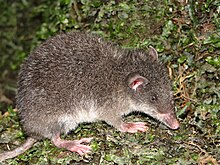Eastern caenolestid
| Eastern caenolestid | |
|---|---|

| |
| Holotype, Sangay National Park, Ecuador | |
| Scientific classification | |
| Domain: | Eukaryota |
| Kingdom: | Animalia |
| Phylum: | Chordata |
| Class: | Mammalia |
| Infraclass: | Marsupialia |
| Order: | Paucituberculata |
| Family: | Caenolestidae |
| Genus: | Caenolestes |
| Species: | C. sangay
|
| Binomial name | |
| Caenolestes sangay Ojala-Barbour et al., 2013
| |
The eastern caenolestid (Caenolestes sangay) is a shrew opossum found on the eastern slopes of the Andes in southern Ecuador.[2]
Etymology
The origin of the genus name (Caenolestes) drives from the Greek words kainos ("new") and lestes ("robber", "pirate"). The origin of the species name (sangay) derives from Sangay National Park, which is the largest Andean national park in Ecuador. The park itself is named after a volcano called Sangay, one of Ecuador's most active volcanoes that lies within the park. Sangay National Park was the site of the discovery of the eastern caenolestid in 2010.
Taxonomy
The eastern caenolestid is one of the five members of
| |||||||||||||||||||||||||||||||||||||||||||||||||
Caenolestid fossils date to as early as the early
References
- ^ Ojala-Barbour, R.; Brito, D.; Pinto, C. (2020) [amended version of 2016 assessment]. "Caenolestes sangay". IUCN Red List of Threatened Species. 2020: e.T51222063A166524217. Retrieved 3 June 2020.
- ^ .
- ^ Simpson, G.G. (1970). "The Argyrolagidae, extinct South American marsupials". Bulletin of the Museum of Comparative Zoology. 139: 1–86.
- ^ Marshall, L.G. (1980). "Systematics of the South American marsupial family Caenolestidae". Fieldiana: Geology. New Series. 5: 1–145.
- ISBN 978-0-226-28242-8.
- JSTOR 3503866.

